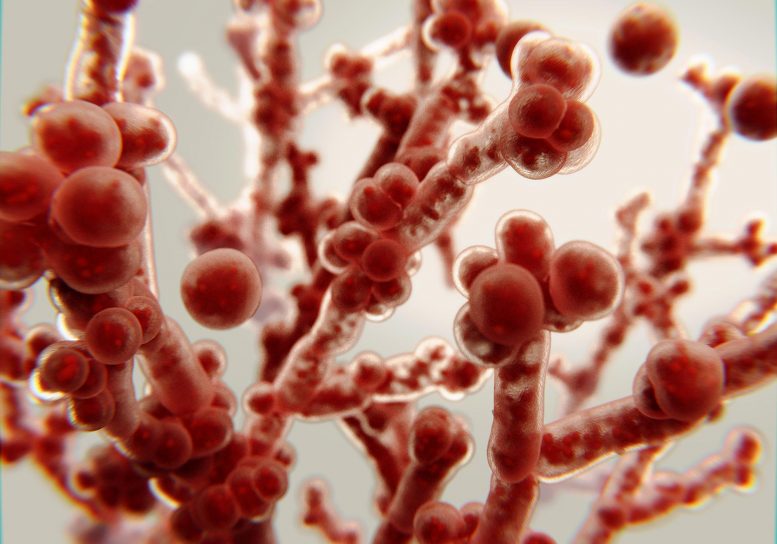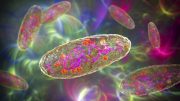
Candida albicans usually co-exists peacefully in the body, but under the right conditions it transforms into hyphae, the dark red filaments pictured above, which can form harmful biofilms.
Research shows that a gut hormone called peptide YY also plays a vital role in maintaining the health of the gut microbiome by preventing helpful fungi from turning into more dangerous, disease-causing forms.
Peptide YY (PYY), a hormone produced by gut endocrine cells that was already known to control appetite, also plays an important role in maintaining the balance of fungi in the digestive system of mammals, according to new research from the University of Chicago.
In a study published in the journal Science, researchers found that specialized immune cells in the small intestine called Paneth cells express a form of PYY that prevents the fungus Candida albicans from turning into its more virulent form. PYY was already known to be produced by endocrine cells in the gut as a hormone that signals satiety, or when an animal has had enough to eat. The new research shows that it also functions as an antimicrobial peptide that selectively allows commensal yeast forms of C. albicans to flourish while keeping its more dangerous forms in check.
“So little is known about what regulates these fungi in our in our microbiome. We know that they’re there, but we have no idea what keeps them in a state that provides health benefit to us,” said Eugene B. Chang, MD, Martin Boyer Professor of Medicine at UChicago and senior author of the study. “We now think that this peptide we discovered is actually important for maintaining fungal commensalism in the gut.”
Regulating the ‘Mycobiome’
Chang and his team didn’t set to explore the fungal side of the gut microbiome, or “mycobiome” as he calls it. Joseph Pierre, PhD, a former postdoctoral scholar in Chang’s lab who is now an Assistant Professor of Nutritional Sciences at the University of Wisconsin-Madison, was studying the enteroendocrine cells in mice that produce PYY when he noticed that it was also present in Paneth cells. These are important immune system defenders in the gut of mammals, secreting several antimicrobial compounds to prevent dangerous bacteria from flourishing.
At first this didn’t make sense, because until then, PYY was only recognized as an appetite hormone. When they tested it against a variety of bacteria, it wasn’t very good at killing them either. But when they ran a computer search for other classes of peptides with a similar structure, they discovered one similar to PYY called magainin 2, which is found on the skin of the African clawed frog. This peptide protects the frogs from infection by both bacteria and fungi, so Chang’s team thought to test PYY’s antifungal properties too. As it turns out, it is not only an effective antifungal agent, but a very specific one as well.
“So little is known about what regulates these fungi in our in our microbiome. We know that they are there, but we have no idea what keeps them in a state that provides health benefit to us.”
— Eugene B. Chang, MD
C. albicans is a yeast that typically grows in small amounts in the mouth, on the skin, and in the intestines. The basic yeast form is commensal, or coexists peacefully in the body, but given the right conditions it transforms into what are called hyphae that branch out to form biofilms. When too much grows, it causes thrush, an infection in the mouth and throat, vaginal yeast infections, or more serious generalized infections in the body. When Chang’s team tested PYY against both forms of the fungus, it effectively prevented growth and killed the more dangerous hyphae while sparing the commensal Candida yeast.
“This is a unique example of an ‘innate’ antimicrobial peptide secreted by Paneth cells that specifically kills the virulent form of this fungi and has no effect on the on the commensal form,” Chang said.
Making the Most Out of Your Molecules
While PYY could be useful as a tool to combat fungal infections, its newly discovered function may play a role in digestive diseases as well. Patients with Crohn’s disease of the ileum, the last portion of the small intestine, often have dysfunctional Paneth cells. Chang said it’s possible that this dysfunction, and lack of PYY, could create an environment for fungi to overgrow and trigger the onset of disease.
The full, unmodified version of PYY has 36 amino acids, and when Paneth cells secrete it into the gut it’s an effective antifungal peptide. But when endocrine cells produce PYY, an enzyme clips off two amino acids to turn it into a hormone that can travel through the bloodstream and tell the brain you’re not hungry. Just like discovering its function from a frog, Chang hopes more research on this peptide will turn up more surprises.
“This is an example of the wisdom and beauty of nature that has repurposed a molecule, so it has two different functions,” he said. “That’s really cool, because this is an efficient way of making the most out of things you already have.”
Reference: “Peptide YY: A Paneth cell antimicrobial peptide that maintains Candida gut commensalism” by Joseph F. Pierre, Brian M. Peters, Diana La Torre, Ashley M. Sidebottom, Yun Tao, Xiaorong Zhu, Candace M. Cham, Ling Wang, Amal Kambal, Katharine G. Harris, Julian F. Silva, Olga Zaborina, John C. Alverdy, Herbert Herzog, Jessica Witchley, Suzanne M. Noble, Vanessa A. Leone and Eugene B. Chang, 3 August 2023, Science.
DOI: 10.1126/science.abq3178
The study was supported by the National Institutes of Health, the Kenneth Rainin Foundation, and the University of Chicago Gastrointestinal Research Foundation. Additional authors include Brian M. Peters from the University of Tennessee; Diana La Torre, Ashley M. Sidebottom, Yun Tao, Xiaorong Zhu, Candace M. Cham, Ling Wang, Amal Kambal, Julian F. Silva, Olga Zaborina, and John C. Alverdy from the University of Chicago; Katharine G. Harris from Franklin College; Herbert Herzog from the Garvan Institute of Medical Research; Suzanne M. Noble and Jessica Witchley from the University of California-San Francisco; and Vanessa A. Leone from the University of Wisconsin – Madison.









Be the first to comment on "Unveiling Peptide YY: A Molecular Maestro of Appetite and Immunity"